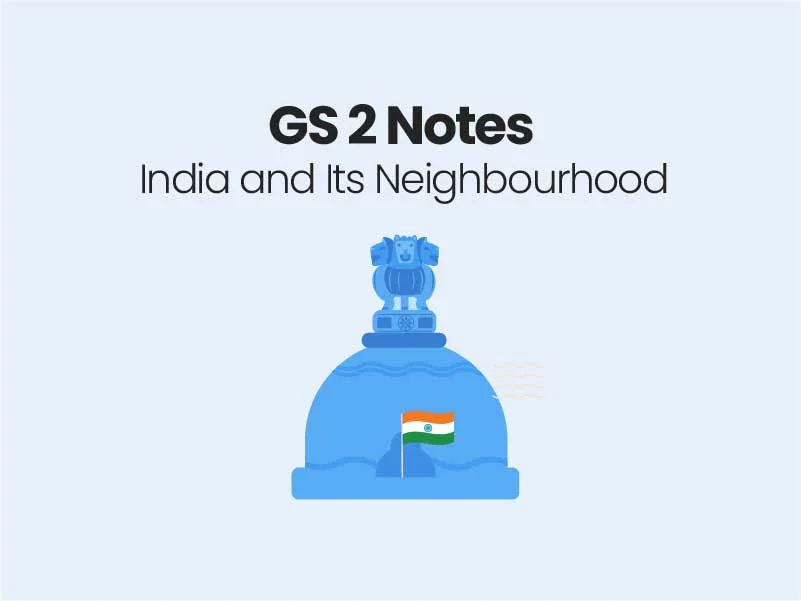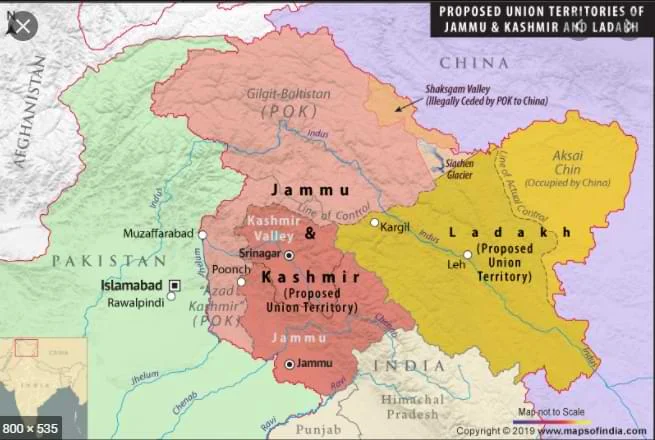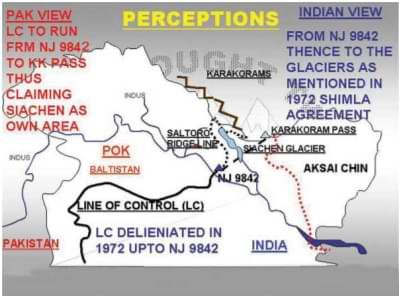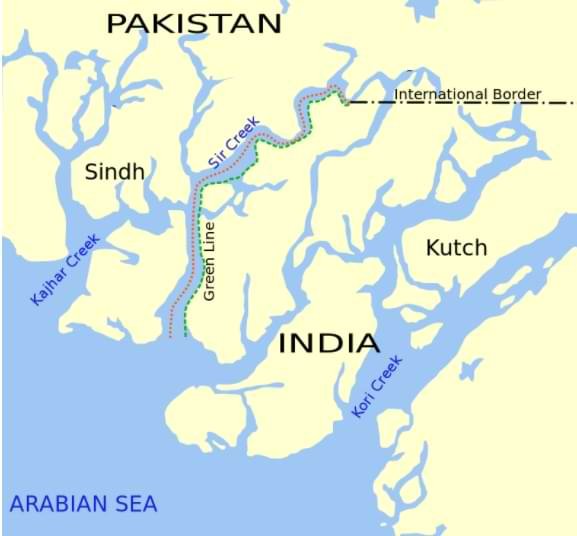
India and Its Neighborhood
India and Pakistan – Major Issues between India and Pakistan

Jammu and Kashmir
- The Indian Independence Act, 1947 created the Republic of India and the Islamic Republic of Pakistan. Princely states had choice to be part of two nations.
- The state of Jammu and Kasmir had an overwhelming Muslim population ruled by a Hindu King, Raja Hari Singh. The state signed standstill agreements with both India and Pakistan and wanted more time to decide the course of their future. Meanwhile, Pakistani army men dressed as tribal invaders from the North West Frontier Province invaded the state on October 22nd, 1947.
- The raja appealed to India for help on October 24th. Prime Minister Nehru on the advice of the then Governor General, Lord Mountbatten asked the Raja to sign the Instrument of Accession to India, it would not have been possible to help otherwise as India was not obliged to help any state which was not a part of it.
- The Instrument of Accession was signed on October 26th October 1947. This document proclaimed the state of Jammu and Kashmir to be an INTEGRAL part of India and surrendered three main subjects to the Central Government. The three subjects were Defence, Communications and External Affairs.
- On December 31st, 1947, India raised this issue at the United Nations. Committed to the principles of the UN Charter and believing in International Law, India thought that this was a simple issue and Pakistan would be asked to move back its troops as they were the aggressors.
- India became a victim of the cold war politics and most of the members of the UNSC took Pakistan’s side and a resolution was moved calling for a ceasefire.
- An UNMOGIP (UN Military Observers Group for India and Pakistan) was appointed.
- The Karachi Agreement of 1949 delineated the Cease Fire Line (CFL) in the state of J & K. The line is up to Point NJ 9842 beyond which lies the Siachen Glacier.
- The UN Resolution calls on both India and Pakistan to withdraw troops from Jammu and Kashmir and a plebiscite to be held once the first condition is achieved. Pakistan refused to comply with the resolution and continues to hold on to 1/3 of the territory of the state illegally.
- Pakistan has tried to unilaterally alter this position, and this had led to three wars between the two sides including 1948 (the 1971 war was fought over the liberation of East Pakistan or modern day Bangladesh. Though the fighting did take place in the western sector.
- The war of 1965 ended in a stalemate with the signing of the Tashkent Agreement in January 1966.
- The war of 1971 was not directly related to the dispute of J&K, however, there were implications. The war was called the Bangladesh Liberation war. The Indians had captured large parts of Sindh, Punjab in the western sector and had liberated East Pakistan and helped in the creation of Bangladesh.
- Prime Ministers Indira Gandhi and Bhutto met at Shimla in January 1972 and signed the Shimla Agreement. This was the best opportunity for India to have crippled the Pakistani Army and insured for a better future.
- The Shimla Agreement also converted the Cease Fire Line (CFL) into the Line of Control (LOC). It also had a clause that India and Pakistan were to work towards achieving peace and both sides would avoid vitriolic campaigns against each other.
- All disputes between the two sides were to be solved bilaterally in a peaceful manner through negotiations. Especially on this issue of J&K, India has been consistent in its position that it is a bilateral issue to be solved by India and Pakistan and there is no place for any third-party intervention.
- Pakistan believes in the exact opposite despite the Shimla Agreement. The treaty, like others, lasted only a few months before Zulfiqar Ali Bhutto continued spewing hatred against India. He is said to have issued a statement which called for bleeding India through a thousand cuts. It is a policy that the deep state continues to follow through unconventional warfare.
- Prime Ministers Atal Bihari Vajpayee and Nawaz Sharif had just concluded the Lahore Agreement of 1999. There was an atmosphere of good will which was conducive towards peace.
Importance of Jammu and Kashmir
- Ideological and Religion: As Pakistan hopes to assume the leadership of the Islamic world, Kashmir will be their stepping stone towards this objective.
- National Interests: J&K acts as a glue to keep Pakistan united. The dispute unites all people and provides a respite to the government which otherwise would have to deal with all the social tensions and insurgency related issues. The Pakistani armed forces command an undue advantage in the nation.
- Strategic Location: The state of Jammu and Kashmir shares borders with Afghanistan, China, Pakistan, and the small Wakhan Strip separates it from the Central Asian Republics. This location gives it an advantage in the geo-political sense. It has been a part of the ancient silk route.
- Resources: The entire Indus river system passes through this state and the nation which controls it gets to dictate terms advantageous to it in the Geo-political sense. Along with this other important economic activities include Tourism, Agriculture etc.

Siachen Dispute
- The Karachi Agreement of 1949 lays down the cease fire line (CFL) in the state J&K up to Point NJ 9842 on the map.
- There is confusion as to where the temporary border goes from there. The Karachi Agreement only says that the Ceasefire line shall run northwards from Point NJ 9842. India lays claim to the entire glacier due to this clause. Pakistan on the other hand insists that the ceasefire line runs eastwards from Point NJ 9842. This would grant them access to the entire glacier.
- Operation Meghdoot was launched by the Indian Army and the posts were captured in 1984 after Pakistan tried to occupy the glacier.

Why is Siachen a disputed region?
- Saltoro Ridge occupation is staking a claim beyond NJ 9842 in the event of an eventual settlement along the Line of Control and the Actual Ground Position Line.
- India has always claimed that the entire state of J&K including Northern Areas acceded to India on 26 Oct 1947. Occupation of Saltoro is therefore the occupation of Indian territory by the Indian Army. It is non-negotiable.
- If the line joining NJ 9842 to Indira Col i.e, the line along Saltoro Ridge is extended to the Indo – Tibet boundary, a major part of Shaksgam Valley illegally ceded to China by Pakistan in 1963 will fall into Indian Kashmir.
River Water Disputes:
- The Indus Waters Treaty is a water-sharing agreement between India and Pakistan signed in 1960. It was brokered by the World Bank.
- The treaty spells out conditions for water-sharing of the River Indus and its five tributaries.
- India got control over the three eastern rivers, which are:
- Ravi
- Beas
- Sutlej
- All the waters of the Eastern Rivers shall be available for the unrestricted use of India until the rise of any unwanted situation.
- Pakistan got control over the three western rivers, which are:
- Indus
- Chenab
- Jhelum
- A Permanent Indus Commission was set up by the United Nations for resolving any disputes that may arise in water sharing, with a mechanism for arbitration to resolve conflicts amicably.
- According to the treaty, India can use the water from the western rivers for domestic, non-consumptive needs such as storage, irrigation, and also the generation of electricity.
- The treaty gives India 20% of the water from the Indus River System and the rest 80% to Pakistan.
- In executing any scheme of flood protection or flood control each country(India/Pakistan) will avoid, as far as practicable, any material damage to the other country.
Indus Waters Treaty Issues
- In 2016, Pakistan had approached the World Bank raising concerns of India’s Kishenganga and Ratle hydroelectric power projects being constructed in Jammu & Kashmir.
- India then requested for neutral experts to inspect the plants, saying that the points raised by Pakistan were technical ones and do not require a court of arbitration (as Pakistan has taken it to an arbitration court).
- The World Bank permitted India to proceed with the projects after talks were concluded between both the countries on the technicalities of the treaty.
- Baglihar Hydro Power Project: This has been built on the Chenab River. It was approved in 1996, work began in 1999. The second phase of the project began in 2012 and was completed in 2015. The project is worth 900 MW. Pakistan raised this issue but did not succeed in the arbitration.
- The Tulbul project (which is a navigation lock-cum-control structure at the mouth of the Wular Lake, situated on the Jhelum from Anantnag to Srinagar and Baramulla) was suspended in 1987 after Pakistan objected to it. Recently, the government decided to review this suspension without taking into account Pakistan’s protests.
- Pakistan’s Left Bank Outfall Drain (LBOD) project passes through the Rann of Kutch in India’s Gujarat. The project was constructed without India’s consent. India has objected because this is in contravention to the IWT. The lower riparian state is in India and hence it needs to be given all details. There is also the danger of flooding in the state of Gujarat.
- Recently, the bilateral relations between India and Pakistan have taken on a downward spiral. In the wake of the Uri attacks on India, Prime Minister Modi remarked that blood and water cannot flow simultaneously indicating to Pakistan that its support to terrorism across the border will lead to India rethinking its generous stance on the IWT. Indeed, many experts believe that the treaty is more favourable towards Pakistan than India.
- To utilize the waters of the Eastern rivers which have been allocated to India for exclusive use, India has constructed Bhakra Dam on Satluj river, Pong and Pandoh Dam on Beas river, and Thein (Ranjit Sagar Dam) on Ravi river.
Options for India
- The treaty’s provisions do not allow a unilateral abrogation.
- Even if India decides to back down from the treaty, the 1969 Vienna Convention on the law of treaties should be abided by.
- This can hamper the country’s image internationally. India’s other neighbouring countries like Bangladesh and Nepal may become skeptical about similar treaties with them.
- Some experts on international affairs think that India should safeguard bilateral treaties if it is aspiring for a permanent seat in the UNSC.
- The move to abrogate the treaty may lead to more problems with respect to terrorist activities.
- India should also build adequate infrastructure to use the entire water before stopping water from Pakistan.
- Another angle is that of China. China, with its support to Pakistan, may block the water from the Brahmaputra to Assam. It can also stop the waters of the Indus which originate in Chinese territory.
Sir Creek
- Sir Creek is a 96-km strip of water disputed between India and Pakistan in the Rann of Kutch marshlands. Originally named Ban Ganga, Sir Creek is named after a British representative.
- The Creek opens up in the Arabian Sea and roughly divides the Kutch region of Gujarat from the Sindh Province of Pakistan.

Issue:
- The dispute lies in the interpretation of the maritime boundary line between Kutch and Sindh. Before India’s independence, the provincial region was a part of the Bombay Presidency of British India.
- But after India’s independence in 1947, Sindh became a part of Pakistan while Kutch remained a part of India.
- Pakistan claims the entire creek as per paragraphs 9 and 10 of the Bombay Government Resolution of 1914 signed between then the Government of Sindh and Rao Maharaj of Kutch.
- The resolution, which demarcated the boundaries between the two territories, included the creek as part of Sindh, thus setting the boundary as the eastern flank of the creek popularly known as Green Line.
- But India claims that the boundary lies mid-channel as depicted in another map drawn in 1925, and implemented by the installation of mid-channel pillars back in 1924.
- The marshland of Sir Creek first became disputed in the early 20th century when the Rao of Kutch and the Chief Commissioner of Sindh Province of British India, due to different perceptions of the boundaries, laid claims over the creek.
- The case was taken up by the then Government of Bombay, which conducted a survey and mandated its verdict in 1914.
- This verdict has two contradictory paragraphs, which make India and Pakistan contenders on the same issue.
- Paragraph 9 of this verdict states that the boundary between Kutch and Sindh lies ‘to the east of the Creek,’ (Green Line) which effectively implies that the creek belonged to Sindh and, therefore, to Pakistan.
- On the other hand, Paragraph 10 states that since Sir Creek is navigable most of the year.
- According to international law and the Thalweg principle, a boundary can only be fixed in the middle of the navigable channel, which means that it has been divided between Sindh and Kutch, and thereby India and Pakistan.
- India has used this para to consistently argue that the boundary needs to be fixed in the middle of the creek.
- Pakistan, however, claims that Sir Creek isn’t navigable but India claims that since it’s navigable in high tide, the boundary should be drawn from the mid channel.
Importance of Sir Creek
- Apart from the strategic location, Sir Creek’s core importance is fishing resources. Sir Creek is considered to be among the largest fishing grounds in Asia.
- Another vital reason for two countries locking horns over this creek is the possible presence of great oil and gas concentration under the sea, which are currently unexploited thanks to the impending deadlock on the issue.
- If Thalweg principle is to be upheld, Pakistan would lose a considerable portion of the territory that was historically part of the province of Sindh
- Acceding to India’s stance would mean shifting of the land/sea terminus point several kilometres to the detriment of Pakistan, leading in turn to a loss of several thousand square kilometres of its Exclusive Economic Zone under the United Nations Convention on Law of the Sea (UNCLOS).
Sino-Pak Cooperation
- In the current times it appears that China is propping up Pakistan against India. In what appears to be a complete violation of international law, China has been delivering missile technology and engaging in nuclear commerce with Pakistan.
- Unmindful of its commitments under International Law, Pakistan ceded a part of this territory called the Shaksgam Valley to China after singing the SinoPak Cooperation Agreement, 1963. It is often said that Sino-Pak friendship is higher than the Himalayas and deeper than the Gwadar port.
China-Pakistan Economic Corridor
- The CPEC is bilateral project between Pakistan and China, intended to promote connectivity across Pakistan with a network of highways, railways, and pipelines accompanied by energy, industrial, and other infrastructure development projects linking the Western part of China to the Gwadar Port in Balochistan, Pakistan running some 3000 km from Xinjiang to Balochistan via Khunjerab Pass in the Northern Parts of Pakistan.
- It will pave the way for China to access the Middle East and Africa from Gwadar Port, enabling China to access the Indian Ocean and in return China will support development projects in Pakistan to overcome the latter’s energy crises and stabilizing its faltering economy.
- CPEC is a part of OBOR.
Issues with CPEC
- CPEC Passes through Pakistan-occupied Kashmir (PoK) and Baluchistan, both of which are home to a long-running insurgency where it faces terrorism and security risks.
- China would also disseminate its ideology and culture in Pakistan through terrestrial distribution of broadcast TV, which will cooperate with Chinese media in the “dissemination of Chinese culture”. A similar Sinification is visible in the Mandalay town of Myanmar which has impacted local architecture and culture.
- CPEC project’s lack of transparency and accountability is a cause of concern, as it may be skewed in favour of China economically and strategically.
- The Chinese approach of not partnering with local companies will not help Pakistan create job opportunities.
- The project may undermine Pakistan’s sovereignty as its foreign policy, especially with India may be dictated by China, complicating the already estranged relations and create political instability in the South Asia;
- The political tension in Afghanistan also may severely impede the benefits of transit corridors in South Asia.
India’s Objections to OBOR-CPEC
- India has not supported OBOR. China’s insistence on establishing the CPEC project through PoK is seen by India as infringing its sovereignty.
- China is building roads and infrastructure in the disputed territory of Gilgit-Balistan, which is under Pakistan’s control but which India claims as a part of Jammu and Kashmir.
- If the CPEC project gets implemented successfully, this would hamper India’s strategic interests in the South Asian region. It will serve Beijing’s strategic ambition to encircle India.
- CPEC can aid Pakistan’s legitimacy in the Kashmir dispute.
- China’s increasing footprints in the South Asian region is detrimental to India’s strategic hold e.g. construction of the Hambantota Port in Sri Lanka provided China with a critical strategic location in the Indian Ocean.
India’s Choice:
- India’s future strategy thrust on CPEC must be based on a careful reassessment of the potential benefits as well as disadvantages from OBOR project.
- India should speed up work on development of its own strategic projects like, Bangladesh, China, India and Myanmar Economic Corridor (BCIM) and Chabahar Port.
- The Asia-Africa Growth Corridor is an India-Japan economic cooperation agreement, it can provide India great strategic benefits and counter China’s OBOR project.
Cross-border Terrorism
- Terrorism emanating from territories under Pakistan’s control remains a core concern in bilateral relations.
- India has consistently stressed the need for Pakistan to take credible, irreversible and verifiable action to end cross border terrorism against India.
- Pakistan has yet not brought the perpetrators of Mumbai terror attacks 2008 to justice in the ongoing trials, even after all the evidence have been provided to them.
- India has firmly stated that it will not tolerate and compromise on issues regarding national security.
- Based on attacks in India and involvement of the neighbouring country, the Indian Army had conducted surgical strikes at various terrorist launch pads across the Line of Control, as an answer to the attack at the army camp in Uri, Jammu and Kashmir.
- India had again hit back over the cross border terror attack on the convoy of Indian security forces in Pulwama by carrying out a successful air strike at a training camp of JeM in Balakot, Pakistan.
Other issues:
- The issue of Fake Indian currency notes (FICN) is a cause for major concern. Pakistan continues to push this into India by various routes such as Nepal, Bangladesh, through the Line of Control (LOC) and through the gulf nations among many others. According to a newspaper article, a study conducted by the National Investigation Agency (NIA) showed that at any given point of time there is INR 4 Billion worth of fake Indian currency which is in circulation.
- The second major issue is the Pakistan Army’s reluctance to shed its power and the resources it controls. Any peace deal with India and the real settlement of disputes will deny the Pakistani armed forces, their power and financial resources.
- India has over 150 nuclear warheads and Pakistan has over 160 nuclear warheads. India is very clear as far its policy is concerned. It has adopted the ‘No first use policy’. However, Pakistan’s nuclear weapons have been designed to target India.
Current Cooperations:
- Economic Ties: As far as the economic cooperation is concerned, the trade between the two countries is little less than USD 2 billion. India still continues to export Pharmaceutical and other surgical instruments to Pakistan.
- India granted Pakistan, the Most Favoured Nation (MFN) in 1996 and suspended it in 2019 after the Pulwama attack
- Pakistan has refused to grant this status to India. Indian industries are far superior to Pakistan’s and this has prevented Pakistan from granting the MFN status to India.
- Trade through Third Party: A lot of trade between the two countries is conducted through third states such as the UAE. As per various reports, the bilateral trade between the two nations is estimated to grow at USD 10 billion, if the relations improve.
- Connectivity: Pakistan has refused India the right to connectivity. India seeks to engage with Afghanistan in the economic terms and transit through Pakistan will be helpful. However, Pakistan has refused to permit Indian trucks to travel to Afghanistan
- India was also pursuing the Iran-Pakistan-India oil pipeline and the Turkmenistan-Afghanistan-Pakistan-India gas pipeline. Both these projects have been stalled presently.
- Cooperation at UN: One area where the two nations are cooperating is the field of UN Peacekeeping forces. The forces serve together. In the past, there has been intelligence cooperation between the two nations. However, it has met with limited success.
- Cooperation at Multilateral groups: Multilateral groups such as the South Asian Association for Regional Cooperation (SAARC) have been stalled due to Pakistan and its bureaucratic nature.
- People to People Contact: The visit to religious shrines between India and Pakistan is governed by the Bilateral Protocol on Visits to Religious Shrines signed between India and Pakistan in 1974. The protocol provides for three Hindu pilgrimages and four Sikh pilgrimages every year to visit 15 shrines in Pakistan while five Pakistan pilgrims visit 7 shrines in India. Ex: In November 2019, India and Pakistan operationalized the Kartarpur Corridor project.
- Another religious corridor project that is explored is the Sharda Peeth corridor project. The temple is located in Pakistan Occupied Kashmir (POK).
- Cultural ties: Normally, cultural relations do improve the relations between the two countries. However, this holds true only when nations have genuine disputes and are keen to settle it. In recent times, Indian movies have been banned in Pakistan and in retaliation the demand for ban on Pakistani artists in India arises.
Enroll today with the best civils service academy and take your first step towards your Civils journey.
Feel free to reach out to us for any inquiries, collaborations, or support. We’re here to help.

